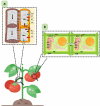Approximate entropy: a promising tool to understand the hidden electrical activity of fruit
- PMID: 37007213
- PMCID: PMC10054301
- DOI: 10.1080/19420889.2023.2195236
Approximate entropy: a promising tool to understand the hidden electrical activity of fruit
Abstract
Fruits, like other parts of the plant, appear to have a rich electrical activity that may contain information. Here, we present data showing differences in the electrome complexity of tomato fruits through ripening and discuss possible physiological processes involved. The complexity of the signals, measured through approximate entropy, varied along the fruit ripening process. When analyzing the fruits individually, a decrease in entropy values was observed when they entered the breaker stage, followed by a tendency to increase again when they entered the light red stage. Consequently, the data obtained showed a decrease in signal complexity in the breaker stage, probably due to some physiological process that ends up predominating to the detriment of others. This result may be linked to processes involved in ripening, such as climacteric. Electrophysiological studies in the reproductive stage of the plant are still scarce, and research in this direction is of paramount importance to understand whether the electrical signals observed can transmit information from reproductive structures to other modules of plants. This work opens the possibility of studying the relationship between the electrical activity and fruit ripening through the analysis of approximate entropy. More studies are necessary to understand whether there is a correlation or a cause-response relationship in the phenomena involved. There is a myriad of possibilities for the applicability of this knowledge to different areas, from understanding the cognitive processes of plants to achieving more accurate and sustainable agriculture.
Keywords: Electrome; fruit herbivory; fruit ripening; machine learning; plant electrophysiology.
© 2023 The Author(s). Published by Informa UK Limited, trading as Taylor & Francis Group.
Conflict of interest statement
No potential conflict of interest was reported by the authors.
Figures



References
-
- Burdon-Sanderson J. Note on the electrical phenomena which accompany stimulation of leaf of Dionea muscipula. Proc R Soc. 1873;21:495–8.
-
- Sheperd VA. From semi-conductors to the rhythms of sensitive plants: the research of J. C. Bose. Cell Mol Biol. 2005;51:607–619. - PubMed
-
- Farmer EE, Gao Y-Q, Lenzoni G, et al. Wound- and mechanostimulated electrical signals control hormone responses. New Phytol. 2020;227(4):1037–1050. - PubMed
LinkOut - more resources
Full Text Sources
